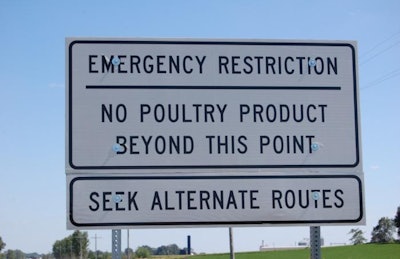
Avian influenza has spread all over the world again in early 2017, suggesting that it will challenge poultry production on every continent for years to come.
In a webinar hosted by WATT Global Media, Dr. Leslie David Sims, a consultant with the Asia Pacific Veterinary Information Service in Australia, said the current wave of infections – affecting North America, Europe, East Asia, the Middle East and Africa – is “a very severe outbreak” and one of the worst waves of avian influenza ever experienced. Sims spoke as part of an expert panel at the May 11 webinar focusing on the challenges presented by avian influenza sponsored by Neogen.
Sims was joined by Dr. David Swayne, laboratory director for the U.S. Department of Agriculture’s Agricultural Research Service’s Southeast Poultry Research Laboratory, and Dr. Aldo Rossi, managing director of world quality assurances and veterinary services for Cobb-Vantress Inc. Here are three questions the panel tackled during the hour-long discussion.
1. Is avian influenza a greater threat to the global poultry industry than it was a decade ago?
Sims said the disease’s current intercontinental movement is very similar to the first international wave of avian influenza in 2005 and 2006, but the severity of the disease is greater than a decade ago.
The largest factor that could make avian influenza more severe is the steadily growing global poultry population. Population and income growth around the world is demanding larger flocks and bigger operations, but Sims said the level of biosecurity isn’t increasing at the same rate, especially in smaller, family-run operations in the developing world.
Across the world, and especially in the United States after the devastating 2014-2015 highly pathogenic avian influenza (HPAI) outbreak, the awareness of the importance of biosecurity is growing. However, free-range and pasture operations will always deal with higher risk of exposure to the virus through the wild bird population. In Asia in particular, commercial poultry’s exposure to wild bird populations will likely lead to greater spread and mutation of H5 avian influenza, he said.
A positive, Sims said, is the growing scrutiny of biosecurity practices surrounding live bird markets in China and Southeast Asia. Internationally, all countries are moving ahead with control programs which could lower the regional risk of avian influenza transmission.
“It’s going to take some time. There’s issues still where we have this patchwork of different types of high and low biosecurity farms in similar areas,” Sims said. “The last seven months it’s been amazing with the number of places where we’re seeing the outbreaks of the disease. Every day, there’s been something new occurring.”
Sims said it’s likely the disease will return to Europe next year. In this wave, the disease has moved to South Korea and Japan unusually quickly. Both countries are also dealing with a separate strain of HPAI – H5N6 – which is causing massive problems in both countries. South Korea is currently dealing with its worst ever avian flu outbreak.
Additionally, the world is currently challenged by the H7N9 virus, which is circulating in China and has the potential to effect humans as well as commercial poultry. Sims warned the disease hasn’t left China yet, but if it’s not brought under control it is possible the virus will move across borders into neighboring countries.
2. As flocks grow globally, are larger operations at greater risk for avian influenza?
Rossi said the world’s growing demand for animal protein – and limited natural resources – means farms will continue to increase in size with efficiency in mind. Unlike their predecessors new farms will be designed with biosecurity as a primary objective.
Rossi spoke about compartmentalization – or the concept of agricultural facilities achieving certification that a business unit, or compartment, follows strict enough biosecurity procedures that it can be trusted to be safe on an international level even during a disease outbreak. The formalized, internationally agreed-upon rules necessary for compartmentalization can be applied to farms of all sizes and be particularly useful on larger farms.
Rossi said regardless of the size of the operation, each worker’s adherence to biosecurity principles is key to maintaining a healthy and biosecure operation. Thanks to higher standards, more animals can be kept in a smaller area with lower disease risk.
3. What steps can be taken to make free-range and pasture poultry farming safer from avian influenza?
In the developed world, consumers are increasingly demanding free-range and pasture-raised poultry products. However, the increased outdoor access could raise the risk of exposure to wild birds and the avian influenza virus.
Swayne said more outdoor access will require farmers to establish stronger health monitoring and surveillance programs, especially during times when migratory birds are likely to pass over the farm. He said the avian influenza outbreaks in the southeastern U.S. in 2017 were all introduced from wild bird populations, so the risk of transmission exists.
Moreover, he said, the poultry industry will need to consider vaccination against avian influenza and other diseases as a way to protect the health of birds with outdoor access. If the industry were able to communicate the benefits a vaccination program would bring, Swayne said, in terms of making a safer, healthier food source, then consumers might be more receptive to the idea of poultry vaccination.


















